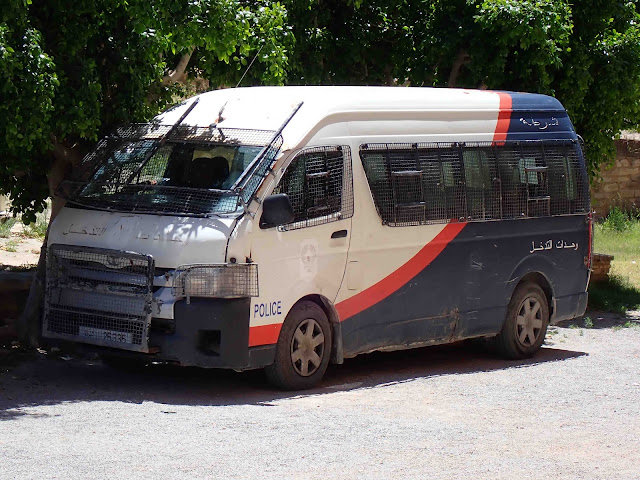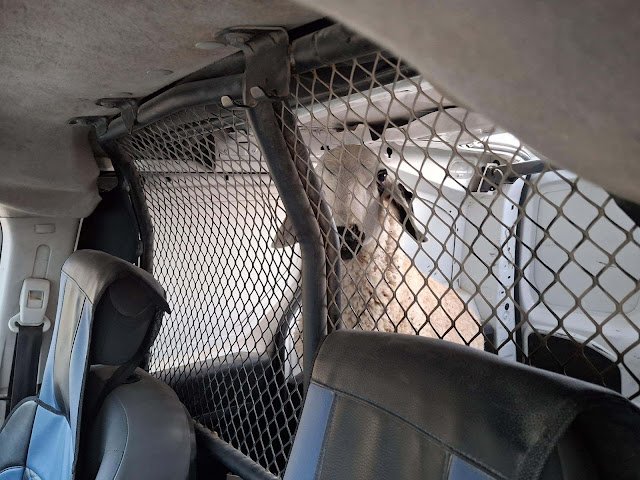Welcome back!
We had spent a few days in and out of taxis in Tunis and the driving was an eye opener. There was blatant disregard for road rules but there was some method to the driving madness. If the traffic was flowing you just kept going. It didn't matter if there was a red traffic light or that there were cars waiting to cross in the other direction. Double lanes became single lanes without warning and drivers just nosed in wherever they could. Cars were often only inches apart. And weaving between any available gaps in the traffic were pedestrians. After the initial shock, we got to understand how it all worked. If you wanted to turn across the traffic or do a u-turn on a busy street you just picked a bit of a gap and went for it. People would slow down and let you turn. Pedestrians just assumed that cars would slow down for them.
It was time to pick up our rental car and explore the rest of the country. We had wisely arranged to pick the car up on the edge of the city so we didn't have to drive through the medina and the busy centre. Unfortunately, the pick up location happened to be on a very busy street. John just pushed out into the traffic and we were off.
As we left the city, the spaces opened up and we found ourselves driving through scrubby, dry, unattractive land. Endless olive groves added some greenery at least. We drove along the exotic-sounding Trans-African Highway and the road was excellent. There were few cars and the driving was fairly easy.
Our first stop (after getting fuel as it only had a quarter of a tank in it when we picked it up!) was El Djem. The attraction here is the second largest existing Roman amphitheatre in the world. Only the Colosseum is larger. We found our way to a perfectly normal smallish car pack, got out of the car and nearly fell over in surprise. We were looking straight at the huge amphitheatre! The car park was right beside it. There were no solid fences and the low-rise town was just scattered around it so nothing obstructed our view. A few times in history, parts of the exterior walls had been knocked down so we could see straight into the inside of it. There were no tour buses and just a small number of people were there. It was amazing!
View from the car park.
I was blown away by this place. Built between 230 and 238AD (they think), the amphitheatre could hold 35,000 people. The rocks came from quarries 30kms away so the feat of building it is doubly impressive.
We had booked five nights on Kerkennah. We figured after our long flights we would need a rest and sleepy Kerkennah seemed the obvious place to do it. I had found accommodation that had an English-speaking owner and great food so we were looking forward to it. We drove off the ferry and headed towards our accommodation. I don't know what I envisioned but these apparently idyllic islands were really just as unattractive as the mainland. Scrubby land was dotted with ramshackle buildings. We drove along a rough dirt road and pulled up at our accommodation which was right opposite a 'beach'. A tiny patch of sand was lined with dead seagrass washed up from the sea. A solitary double umbrella stood at the water's edge and not many people seemed to be around. It all seemed a bit derelict.
Apart from the attraction of the sea, the big 'site' here is the ruins of Borj el Hsar. This is one of only two sites in Tunisia where ancient Phoenician buildings weren't destroyed by subsequent civilisations. The site is an amazing 2,900 years old and is completely unprotected. The remains of an old fence could be seen around it but that was it. Anyone can just wander all over it. The most astonishing thing was that there were multiple mosaics that were exposed to the elements and anyone could just walk on them. It was clear that many were disintegrating. I'm really surprised about this considering how much care went into preserving mosaics in the Bardo Museum in Tunis. I did see some tell-tale glimpses of a mesh that's used over mosaics in places though. We've seen at other sites how they lay down the mesh then put dirt over the top to protect the mosaics. I think this work must have been done a long time ago though as many parts weren't protected.
Going........ A section of mosaic.
Gone.......This part was presumably the same pattern but it was now just a mass of scattered pieces.
A Spanish fort looked over the Phoenician ruins.
One of my walks led along the coast which I thought would be lovely but the entire track was lined with rubbish. We soon learned that many places seem to be ad hoc tips. John's bike wasn't proving to be comfortable either so we abandoned our daily walk and ride the next day and did a driving tour of the islands. To be honest, there's not a lot to report! We saw plenty more narrow, sea grass-lined beaches, date palms in poor condition and unattractive towns. Some people talk about how beautiful these islands are but unfortunately, we just can't see it.
One of the highlights of our stay was spending time with Monia, the owner, and Issam, the waiter. Monia was an effervescent bundle of enthusiasm with a passion for baking cakes and feeding people. Issam seemed to be permanently smiling although strangely, he's not smiling in this photo. John taught him to say 'strewth!' and he said it at the funniest of times. Only, in his accent, it more came out as 'strroof!"
We had heard about a special religious festival that would be starting on Friday, our last day on the islands. The Friday is a public holiday. It's a time for families to get together and lamb is traditionally eaten. Apparently sheep are expensive this year - about $500 Aussie! Many people will apparently only be eating a small amount this year but, despite that, we saw sheep everywhere tethered on the side of the roads or being transported in the back of utes. Clearly they were being sold and transported in readiness for the festival. It was sad to know that they wouldn't be around in a few days.
Two days before the festival started, Issam pulled up in a small delivery van. He parked and went inside but we could hear bleating coming from the van. Here's what we found inside.
Our amazing dinner that night was accompanied by the continual bleating from inside the parked van. After a while it went quiet though and it wasn't til we finished dinner that we saw that the sheep was now tied up outside the kitchen. Monia told us how sad she was about the sheep being butchered. She told us she thought the festival was horrible if sheep had to be killed, however every night she happily served up meat and fish to us, even though I clearly gave her the option to serve me vegetarian. In fact we struggled to get enough vegetables at all. She took great delight in choosing a fish for John from a bowl of them. Clearly meat is ok if she doesn't see the animal alive first!
We had heard that our small hotel was going to be full on the Thursday and Friday nights, presumably for the festival holiday, which was a shame as we had enjoyed the peace of being here on our own. Six of the newcomers at the accommodation were a group from Tunis. They were older Muslims and, in typical Tunisian adaptability, one woman wore the traditional scarf and long dress, the other women wore western clothes and the men wore shorts and t-shirts. Most of them spoke reasonable English and were lovely to talk to. They were even able to translate Monia's excited explanation of dinner to tell me that I wasn't eating chicken like I thought but guinea fowl! We thought we understood that the new guests had organised the sheep but they said they didn't - they were here for the seafood. Why the sheep was organised still remains a mystery to us. There were heaps of staff though so maybe it was mostly for them.
Friday arrived and John returned his bike to the nearby big town and I drove to pick him up. The usually bustling town was completely dead. We soon realised this holiday is a bit like our Christmas. Every shop was closed - except for the butcher shops. Sheep carcasses hung inside - or outside - and people were queueing to buy the meat. I drove up a side road and saw blood in the gutter that runs down the cobblestoned lanes. John was waiting at the bike shop, next to a couple who were burning the hair off a sheep's head. A headless sheepskin, bloodied at the neck, lay nearby. Down another laneway, a woman worked with sheep intestines and we saw other ladies cleaning intestines in the sea.
After having made it clear to Monia that we only wanted a small dinner (again!), that night we were served the usual entree of tuna, bread and tomato spread which was followed by a traditional 'brik' a kind of meat and egg pastry. That was followed by the traditional lamb stew that is eaten at this festival. Monia came up to me just as I took the first bite - and realised I had bitten into a piece of kidney. Monia wanted to know what we thought of the special dish. I forced myself to swallow and made the appropriate yum noises - I hope! If we picked out the kidney and the very strange-looking white meat parts (sweetbreads?) the rest of the dish was fantastic though. When Issam cleared away our plates we thought we had escaped the onslaught of food but then he brought back fresh plates. He then served another huge platter of lamb cooked in another way plus three lamb chops plus a salad! It was a meat-fest and we barely touched it. We somehow managed to squeeze in the delicious desert though......
John made the comment that he doesn't think we've ever overeaten so consistently before and he's right. We need to be a lot more careful from now on.
I almost forgot to mention Tatu, the pup. This ball of energy loved biting our ankles but was way too cute to get cross at.
Our stay at Kerkennah wasn't what we expected. It wasn't beautiful, the sea was too shallow for a proper swim and our food costs were well beyond what we had budgeted for, however meeting Monia and Issam (and Tatu!) more than made up for it. We will always hold fond memories of our stay here.
Til next time!
Heather and John


































No comments:
Post a Comment